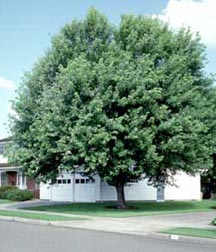Trees beat more than heat!
 (by Ethan Gilsdorf) Antonette Campbell was justifiably shocked when city workers mistakenly sawed down a 20-meter oak tree last May that shaded the eastern facade of her home.
(by Ethan Gilsdorf) Antonette Campbell was justifiably shocked when city workers mistakenly sawed down a 20-meter oak tree last May that shaded the eastern facade of her home.Besides the emotional distress, the error has an unexpected consequence: she noticed her air conditioner began running a couples hours earlier each morning. Conventional wisdom is that just one shady tree can save a homeowner $80 a year in energy costs, but Campbell claimed her bills skyrocketed once the oak disappeared - up to $120 more some months.
Many cities are wishing they had more green space – if for no other reason than to give pedestrians a shady oasis. The “heat island” effect of densely developed spaces causes urban air to be up to 3 C hotter than the surrounding countryside, according to the Environmental Protection Agency.
Yes, humble street trees cool the air, reduce pollution, and absorb storm water runoff, say forestry experts. But the benefits aren’t only ecological. Property values are 18 to 25 per cent higher for houses surrounded by tress. Consumers spend up to 13 per cent more at shops near green landscapes. One study even suggests patients who can see tress out their windows are hospitalized, on average, 8 per cent fewer days.
Dragged kicking and screaming – and sweating – citizens and civic leaders are finally understanding the importance in the so-called “urban tree canopy”. But their efforts to increase investment in tree-lined streets and halt the spread of asphalt parking lots aren’t a moment too soon. Overall, urban trees in America, as in many other parts of the world, are in a woeful state.
“Every city we’ve looked at, about three dozen shows a decline of about 30 per cent of the urban tree canopy in the past 10 to 15 years,” says Deborah Glangloff, executive director of American Forests. In some cities, the loss from disease, development and neglect has been catastrophic. In Washington, D.C., for example, 65 per cent of heavily forested areas disappeared between 1973 and 1997 – forests that once covered a third of the district now covers a tenth.
In the next 50 years, total American land mass reclassified from forest to urban is expected to equal the size of Montana, suggests US Forest Service data.
To reverse the trend, cities like Jacksonville, San Francisco, Albuquerque, Des Moines and Indianapolis have ambitious urban reforestation plans. LA wants to plant one million trees. The Sacramento region has a goal to double the urban canopy in 40 years; last month; Baltimore announced plans to double theirs a decade sooner.
Washington, D.C. is partnering with tree-planting groups and non-profits like Casey Trees Endowment Fund, an organization with a $50 million grant to combat the precipitous canopy decline. The fund’s urban forester program trains volunteers like Antoinette Campbell to conduct on-site censuses that locate, measure, and identify every tree in the city.
The data collected by groups like Casey Trees is crunched by a US Forest Service computer model, which produces a precise environmental and economic value for each tree. For example: a 20-meter American Lindin at the corner of Potomac Ave and E Street in the southeast quadrant of Washington stores 1.4 kilograms of carbon and removes 123.503 grams of sulphur dioxide from the atmosphere each year. To remove that same amount of pollution would other cost society $5.44 annually – multiply that by DC’s 1.9 million trees and the benefits add up.
Urban trees also reduce flow of pollutants into rivers and storm water runoff, a problem largely caused by impervious surfaces like concrete. “A good tree cover can help protect the quality of the Anacostia and Potomac River by reducing storm water runoff”, says Mayor Williams.
Foliage slows the rain so it gets absorbed better, rather than overwhelming drainage systems, explains Ms. Gangloff. For example, a 2005 study of Boulder, Colorado’s municipal trees found that the average tree intercepts 4000 litres of storm water annually, saving the city $523,311 in storm water retention costs.
For municipalities already struggling to meet the Environmental Protection Agency’s air quality goals and build adequate wastewater treatment facilities, urban trees offer a high return on investment. The Boulder report estimates the city gets $3.67 return on every dollar spent on the urban forest.
You can return to the main Market News page, or press the Back button on your browser.

